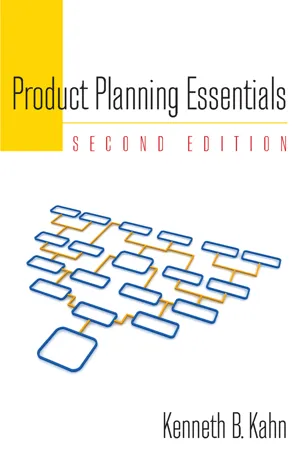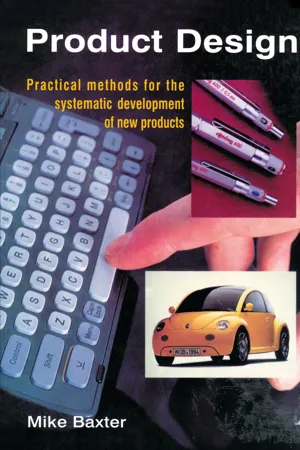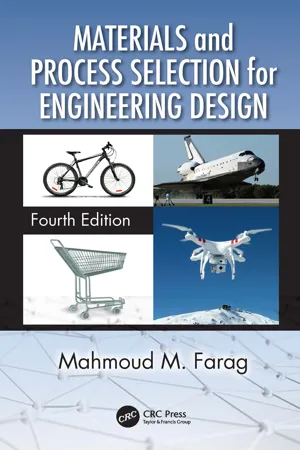Concept Screening in Product Development
Concept screening in product development involves evaluating and selecting potential product ideas to determine which ones are most viable for further development. This process typically involves criteria such as technical feasibility, market potential, and alignment with business objectives. By systematically assessing and prioritizing concepts, organizations can focus their resources on the most promising ideas, ultimately leading to more successful product launches.
5 Key excerpts on "Concept Screening in Product Development"
- eBook - ePub
- Kenneth Kahn(Author)
- 2014(Publication Date)
- Routledge(Publisher)
...Instead, these companies prefer to begin the process with a clean slate in order to provide an environment for greater innovation. Other companies prefer to conduct an opportunity identification stage first to provide boundaries for their product development process. The rationale is that concept generation can get off-track and present ideas that go beyond what the company would want to offer. The opportunity identification stage has management delineate what it will accept as a new product opportunity and thereby provide a greater focus in the concept generation stage. Exhibit 2.3 Schematic of a Product Development Process Pretechnical evaluation is the third stage in the product development process. Here product concepts are evaluated and prioritized. An important element in the pretechnical evaluation stage is a business analysis conducted on the product concept. Those concepts showing the greatest potential to meet company objectives and goals are further defined via product protocols. The gate at the end of the pretechnical evaluation stage is selection of a final set of concepts to continue in the product development process and approval of their respective product protocols. The fourth stage in the product development process is technical development. In this stage, the technology behind the product concept is realized and tested to ensure that it meets the specifications in the product protocol. A viable business or marketing plan is constructed. The gate at the conclusion of this stage assesses whether a tangible product has been developed and functions as desired. The financial viability and marketability (profit potential) of the product also is gauged in order to determine whether to continue work on the product. The fifth stage of the product development process is the launch. This stage comprises activities related to solidifying the market acceptance of the new product, including market testing, prelaunch preparation, launch, and postlaunch control...
- eBook - ePub
- Robert E Stevens, David L Loudon, Morris E Ruddick, Bruce Wrenn, Philip K Sherwood(Authors)
- 2012(Publication Date)
- Routledge(Publisher)
...Chapter 14 Concept/Product Testing When all is said and done, a product must be accepted by the consumer in order to be successful. Technology is a wonderful thing, but regardless of how technically advanced or well designed a product is, it must pass the test of consumer trial and repeat purchase. The successful product, then, is the one that has created enough interest for trial and has met needs sufficiently well to become a satisfactory alternative in the marketplace. In order to improve the chances of a product achieving acceptance in the marketplace, a systematic approach to product testing is prudent. Product testing has several stages. In this chapter we will discuss the following: • Concept testing • Developmental testing • Fit of product/concept • Testing Techniques We will then address the testing procedures (i.e., location and methods) that can be used to perform these product tests. CONCEPT TESTING Concept testing begins with the generation and screening of ideas. Ideas are generated that will mesh with the existing product lines and will compliment the overall goals of the organization. Once the ideas are developed, screening provides a preliminary evaluation of new products with the objective to identify the most promising ones and eliminate the poorer ideas as quickly and inexpensively as possible. The basic methods of idea generation are: • Brainstorming • Focus groups • Synectics • Problem detection Brainstorming dates back to the late 1930s and is popular with many groups for its dynamic, creative atmosphere. Although the format may vary, the groups are normally small working sessions where the objective is to create as many ideas as possible quickly and in a noncritical manner. This approach can produce many ideas in a short period of time, with no guarantee that the ideas will be something that can be commercialized. Focus groups are used frequently to refine concepts and are sometimes used for idea generation...
- eBook - ePub
- Mike Baxter(Author)
- 2018(Publication Date)
- CRC Press(Publisher)
...The concept that turned out to be one of the most distinguishing design features of the entire product started life as a highly practical but prosaic problem. Where do you put the batteries in a product too small and too packed with other features to leave a battery compartment! Original drawings of the Psion Series 3 by Frazer Designers Key Concepts 1. Establish aims and scope for concept design Different design projects will have very different objectives and constraints determining how radical or incremental the concepts need to be. These must be clearly established, with guidance from the opportunity specification. 2. Generate lots of concepts Concept design is usually considered to be the creative heart of the design process. As a result, creative idea generation techniques are used most often at this stage. Several techniques exist for the force-generation of new product concepts. These are likely to increase the number of ideas generated from a few to many tens or even hundreds of concepts. 3. Select the best Concept selection techniques select the best concept against criteria derived from the opportunity specification. Probably more importantly, they provide a framework for hybridising and expanding the range of concepts generated initially. Concept selection can, therefore, comprise a highly creative and invaluable conclusion to the concept design process. Design Toolkit Product function analysis Product function analysis is a method of systematically analysing the functions performed by a product (as perceived by the user). Also known as FAST analysis (Function Analysis Systematic Technique), it is the most basic and probably the most important analytical technique in new product development. All you need for product function analysis is to know how the product will operate in use. You must know, or be able to predict, the functions of the product as perceived by the customer and how the customer rates the relative importance of these functions...
- Mahmoud M. Farag(Author)
- 2020(Publication Date)
- CRC Press(Publisher)
...The economic analysis also estimates sources and cost of financing based on the rate of interest and schedule of payment. The model should allow for a “what if” analysis to allow the product development team to assess the sensitivity of the product cost to changes in different elements of cost. 1.2.5 Selecting an optimum Solution The final stage of the feasibility study identifies an optimum solution. Selection is usually based on economics as well as technical specifications, since the product is expected to satisfy the customer needs at an acceptable price. This process involves trade-offs between a variety of diverse factors, such as Customer needs Physical characteristics of size and weight Expected life and reliability under service conditions Energy needs Maintenance requirements and operating costs Availability and cost of materials and manufacturing processes Environmental impact Quantity of production Expected delivery date A quantitative method that can be used in concept selection gives weight to product specifications according to their importance to the function of the product and preference of the customer. The total score of each concept is determined by the weighted sum of the ratings of its characteristics, as shown in Table 1.3. Table 1.3 Concept Selection The optimum solution should be acceptable not only to the consumer of the product but also to the society in general. If other members of the community object to the product, whether for legal or safety reasons, causing harm to the environment, or merely because of social customs or habit, then it may not be successful. This part of the study requires an understanding of the structure and the needs of the society and any changes that may occur during the intended lifetime of the product...
- eBook - ePub
The Idea Agent
The Handbook on Creative Processes
- Jonas Michanek, Andréas Breiler(Authors)
- 2013(Publication Date)
- Routledge(Publisher)
...Either The Idea Agentt will have had a discussion with the project owner at an earlier stage in the process and have the selection criteria available, or the project owner can be encouraged to communicate directly with the team. Team members will then have the opportunity to ask questions and receive guidelines for the values or factors that will steer the remainder of the process. A Quick Guide to Screening and Development Screening and Development — Step-by-Step In the organizational phase, you can choose to apply one of two primary work processes that are similar in nature, but which have one basic difference. This difference may appear superficial but it can have a profound effect on the end result. You can either opt to focus on the potentiality of individual ideas, or you can choose to concentrate your ideas into clusters with a collective impact on the end result (by “clusters” we mean a group of ideas within one particular subject area). If you choose to focus on individual ideas, each idea should be assessed individually and on its own merits, regardless of the subject area it concerns. Each idea originator will therefore have more opportunity to develop their own “babies,” and the project owner will have less influence in the initial stages. This approach can be beneficial if the focus area is relatively broad and the project owner has relatively few predefined requirements for the end result. On the other hand, if the project owner has predefined a segment for the focus area that the result should address, a cluster method may be more appropriate. Each idea then becomes a part of a cluster or a subject area, with each area being assessed on the basis of its relevance to the issue. In other words, no initial attention is paid to individual ideas, instead the ideas contained in the clusters considered most relevant after evaluation are then developed further...




